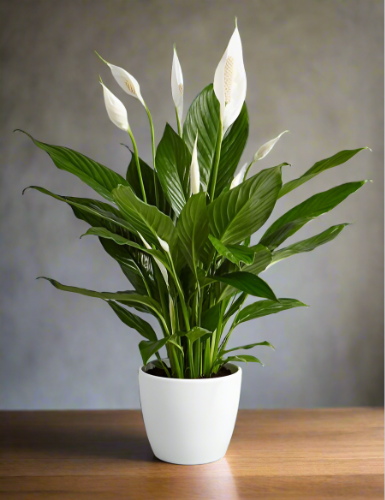Peace Lily
Peace Lily
Couldn't load pickup availability
About the Plant
About the Plant
The Peace Lily, scientifically known as Spathiphyllum wallisii, is a popular indoor plant known for its stunning white flowers and lush green leaves. This elegant plant not only adds beauty to your space but also improves indoor air quality by filtering out harmful pollutants.
Materials and care
Materials and care
Sunlight: Low to bright, indirect light
Water: Keep soil moist, but not waterlogged; water when the top inch is dry
Soil: Well-draining potting mix
Fertilizing: Monthly during the growing season (spring and summer)
Grooming: Remove yellowing leaves and spent flowers
Repotting: Every 1-2 years as needed
Why you'll love it
Why you'll love it
🌿 Elegant Blooms: The Peace Lily's beautiful white flowers are a striking contrast against its deep green leaves, making it a visually appealing addition to any room.
🌿 Low Maintenance: Ideal for busy lifestyles, the Peace Lily thrives with minimal care and attention.
🌿 Air Purifier: This plant is excellent at improving indoor air quality by removing toxins like formaldehyde and benzene.
🌿 Symbol of Peace: The Peace Lily symbolizes purity and tranquility, making it a thoughtful gift for any occasion.
Share



Huge Discounts on Bulk Orders
Know More about this Plant
🌿 Peace Lily: The Epitome of Elegance and Tranquility 🌿
The Peace Lily is a beloved houseplant known for its graceful white blooms and lush foliage. This plant not only enhances the aesthetic appeal of your home or office but also offers numerous benefits, including air purification and ease of care.
Why Choose the Peace Lily?
✨ Air Purification: The Peace Lily is renowned for its ability to filter out harmful pollutants from the air, such as formaldehyde, benzene, and trichloroethylene. Having this plant in your space contributes to a healthier environment. 🏡💚
🌞 Adaptable Light Requirements: Thrives in low to bright, indirect light, making it suitable for various indoor settings. It's perfect for those darker corners where other plants might struggle.
💧 Easy Watering: Keep the soil consistently moist but not waterlogged. Water when the top inch of soil feels dry, ensuring that the plant stays hydrated without sitting in water.
🌡️ Temperature: Prefers temperatures between 65-80°F (18-27°C), making it well-suited for indoor environments.
🪴 Soil: Use a well-draining potting mix to prevent waterlogging, which can lead to root rot.
📏 Growth: The Peace Lily can grow up to 2-3 feet tall, making it a striking centerpiece for any room.
Perfect for Gifting:
🎁 Ideal Gift Choice: With its elegant appearance and symbolic meaning of peace and purity, the Peace Lily is a perfect gift for housewarmings, weddings, birthdays, and corporate events. 🌿🎉
Health Benefits:
🌿 Mental Well-being: The presence of greenery has been shown to reduce stress and enhance mood, making the Peace Lily a wonderful addition to your living or working space.
Propagation Tips:
🌿 Division: Easily propagate by dividing the plant during repotting. Ensure each division has a portion of the root system and foliage, and plant in fresh, well-draining soil.
Frequently Asked Questions about this Plant
How often should I water my Peace Lily?
Water your Peace Lily when the top inch of soil feels dry. Keep the soil consistently moist but not waterlogged.
What kind of light does a Peace Lily need?
Peace Lilies thrive in low to bright, indirect light. They can tolerate low light conditions but may produce more flowers with brighter light.
Why are the leaves of my Peace Lily turning yellow?
Yellow leaves can indicate overwatering or underwatering. Ensure the soil stays consistently moist but not waterlogged, and adjust your watering schedule as needed.
Can Peace Lilies be kept outdoors?
Peace Lilies can be kept outdoors in warm, shaded areas. They prefer temperatures between 65-80°F (18-27°C) and should be brought indoors if temperatures drop below 50°F (10°C).
How do I propagate my Peace Lily?
Peace Lilies can be easily propagated by division. During repotting, gently separate the plant into smaller sections, ensuring each section has roots and foliage, and plant in fresh soil.



